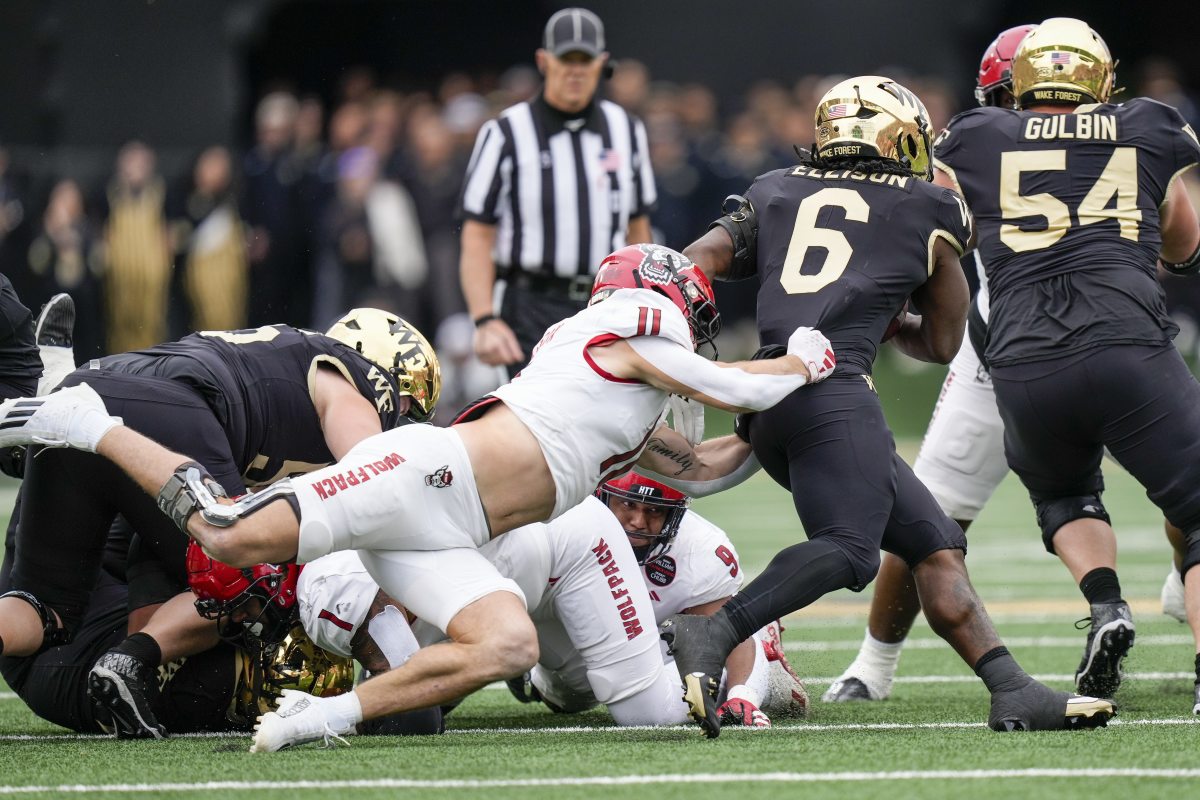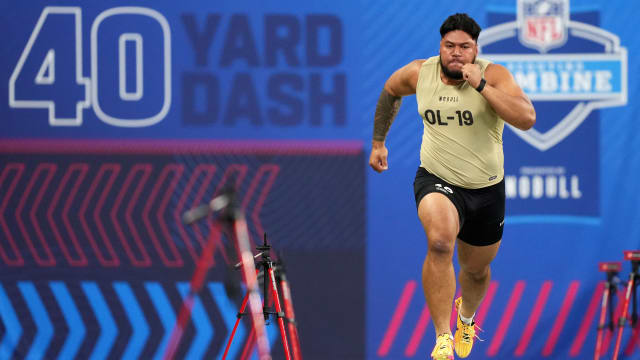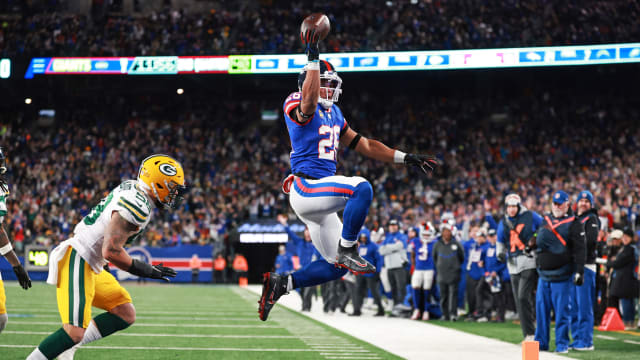
Seven-Round Packers Mock Draft: NC State’s Payton Wilson in First Round
The NFL Scouting Combine is over. After a week in Indianapolis, it's back to business as usual for the Green Bay Packers.
General manager Brian Gutekunst will attack some of his needs in free agency, but adding a free agent has never stopped him from taking that same position in the draft as well.
Using the PFF simulator with no trades this week, I was able to add some help to the front seven, and offensive line with a focus on their results from the Scouting Combine.
First Round: Payton Wilson, LB, NC State
After years of allegedly devaluing the linebacker position, Gutekunst takes his second first-round linebacker in three years.
Wilson blew up the Scouting Combine with a blistering 4.43 time in the 40-yard-dash.
Between Wilson and Texas A&M's Edgerrin Cooper, you can decide who the most athletic linebacker in the class is, but Wilson would be another athletic marvel next to Quay Walker, who the Packers are trying to get the most out of in 2024.
Wilson's athleticism and the Packers' need to add a linebacker gave him the nod in this simulation over Duke's Graham Barton and Washington's Troy Fautanu, a pair of excellent offensive linemen.
Second Round: Graham Barton, OL, Duke
The offensive line almost always is a priority for Gutekunst. Protecting a franchise quarterback should always be at the forefront of anyone's mind when building a team.
Gutekunst has said he felt the offensive line class is strong, and if there were ever a player to fit the typical preferences that Gutekunst has had in selecting offensive linemen, it's Duke's Graham Barton.
Barton was in consideration in the first round, so we were thrilled to get him at 41.
Barton said at the Scouting Combine that he felt he could play all five positions on the offensive line.
He's built similarly as a prospect in the way Elgton Jenkins was when the Packers drafted him. Could they pick him in a similar spot to the one they drafted Jenkins at in 2019?
The Packers had a formal meeting with Barton at the Combine, which could indicate interest.
The only question would be positional fit. His arms measured in at 32 7/8 inches, which could have the Packers allow him to stick at tackle before potentially moving him inside.
Either way, adding a versatile chess piece on the offensive line is never a bad idea, and getting a player like this in the early part of the second round would be a boon for Jordan Love and the offense.
Second Round: Kris Jenkins, DL, Michigan
Stop me if you've heard this before: The Packers were terrible at stopping opposing run games last year.
It's true. They were.
It's hard to fix that simply by changing defensive coordinators, so there was an opportunity to add a player to the mix that was a run-stuffer in college.
Kris Jenkins, the nephew of former Packers' defensive lineman Cullen Jenkins, was one of the top run defenders in college football a season ago. According to PFF, Jenkins had 26 stops in the run game and an overall grade against the run of 82.3.
It's unclear how the Packers will use their interior defensive linemen under new coordinator Jeff Hafley. It's possible Colby Wooden or Karl Brooks could be asked to play some defensive end due to their size.
Jenkins would add another true interior defensive lineman to the mix and serve as a potential replacement for TJ Slaton, who is set to be a free agent following the 2024 season.
Third Round: Calen Bullock, S, USC
The safety class is not great in 2024, and some players may have taken themselves out of consideration altogether with a poor showing at the Combine.
The Packers need a couple of bodies at that position, and there may not be a safety with better ball skills than Calen Bullock.
Bullock picked off nine passes in three seasons and would give the secondary a boost in the playmaking department, where they were woefully inadequate a season ago.
Bullock would need to improve his tackling, but that might be a trade-off the Packers are willing to take if he makes enough plays.
Third Round: Max Melton, CB, Rutgers
Max Melton is Bo Melton's brother.
That storyline has been discussed enough at this point, but Melton is not simply a cute anecdote coming out of college. He can play, and he might be the top option as a slot cornerback coming out of the Combine.
The slot position is open at the moment, with Keisean Nixon set to hit free agency when the new league-year begins in a week.
Melton had a relative athletic score of 9.65, and was a stalwart on special teams, as well, where he blocked a school-record four punts.
Melton may not make it to the third round when the real draft comes around, but in this situation, picking him was a no-brainer.
Fourth Round: Isaac Guerendo, RB, Louisville
The Packers need a running back, and maybe two depending on how they view the future at the position.
They may be looking for a free agent running back, but they'll likely look at the draft for a complement to Aaron Jones.
Guerendo impressed at the East-West Shrine Bowl, and continued his strong offseason with a big performance at the Scouting Combine.
Guerendo can flat out fly, he ran a 4.33 in the 40-yard-dash at the Combine and could give the Packers a speed element that their backfield is missing.
He also has experience as a returner, which the Packers could find valuable in the wake of Keisean Nixon's free agency.
Fifth Round: Joe Milton III, QB, Tennessee
At the Combine, Gutekunst said he wanted to get back to regularly drafting a quarterback. His reasoning makes sense. Quarterback is the most valuable position in all of sports.
There may not be a stronger arm in this draft class than Tennessee's Joe Milton. Milton, however, has a similar issue to the one Ronnie Bass had in Disney's Remember The Titans. He can throw the ball a mile, but he can't pitch it 3 yards.
Milton's arm is as strong as they come, but his accuracy is spotty, at best. Perhaps the Packers could look at Milton as a developmental prospect who had the potential to play really well in preseason games.
If he developed and played well in limited action, he could net the Packers a future asset in the future.
Sixth Round: Tanor Bortolini, C, Wisconsin
Bortolini is another versatile offensive lineman who played all five positions at Wisconsin. His final season was spent at center, which is where he projects to play in the NFL.
The Packers could use an insurance policy for Josh Myers, who is on an expiring contract.
Bortolini's 1.69 10-yard split broke the record of retired former Philadelphia Eagles' center Jason Kelce.
He fits the mold of athleticism and versatility the Packers have typically liked, and they need some reinforcements on the depth of the interior offensive line, giving Bortolini a nod here.
Sixth Round: Cornelius Johnson, WR, Michigan
A receiver?
Yes, a receiver.
Cornelius Johnson could be one of the hidden gems of this draft class.
He's 6-foot-2, 216 pounds, and ran the 40-yard dash in 4.44 seconds. What gives Johnson the nod here, however, is not only his upside as a receiver but his ability on special teams. Johnson played 106 snaps of special teams, and only six were as a returner. He can play in coverage.
The highlight of his career on special teams was blocking a punt against Iowa in Michigan's 42-3 win over the Hawkeyes in the 2021 Big Ten Championship Game.
Seventh Round: Myles Cole, Edge, Texas Tech
Cole was one of the athletic marvels of this class of pass rushers and could be a developmental prospect at the back of Green Bay's defensive end room.
Cole's production started to tick up in his final season for the Red Raiders with 3.5 sacks, but this is a pick truly based on his traits.
With a 9.96 RAS at 6-foot-6, 278 pounds, this is a pick that is worth a shot later in the draft.
Seventh Round: Deantre Prince, CB, Ole Miss
Prince comes in as the final pick as a developmental cornerback.
He is under the weight threshold the Packers have typically preferred, weighing in at 183 pounds at the Combine, but did well in all other areas that were tested at the Combine.
Prince would play at the back of the cornerback room and have a chance to compete on special teams, where he played 341 snaps in college.
What Worked?
Solidifying the line of scrimmage is always a good strategy. Adding a versatile offensive lineman like Barton and a potential upside defensive tackle in Jenkins gives the Packers two building blocks up front on both sides to build around.
Melton should be able to start at cornerback in the slot from the day he arrives in camp, and Guerendo is an athletic marvel who offers some upside as a potential long-term replacement for Aaron Jones.
Bortolini offers depth on the interior of the offensive line, and Joe Milton is a talented prospect who accomplishes Gutekunst's mission of adding a quarterback in every draft the way his predecessor, Ron Wolf used to.
What Didn't Work?
Sometimes the board does not fall your way when you have certain positions of need. The Packers and Gutekunst learned that in the 2020 NFL Draft, for example, when they were looking for a receiver potentially to push their team over the hump and back into the Super Bowl.
They saw every receiver they liked picked in front of them in each of the first three rounds, and ended up not drafting one altogether.
Cornerback did not quite work out that way in this simulation, but Gutekunst would likely want to add a defensive back before the third round. Unfortunately, that was not in the cards this time around.
Gutekunst would likely be hoping that he was able to secure a couple of defensive backs in free agency or banking on the development of players like Anthony Johnson Jr. at safety or Carrington Valentine at cornerback.









